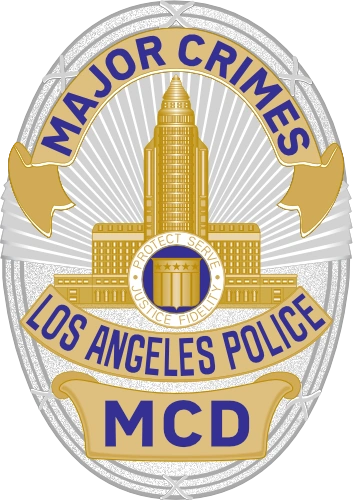| “ | Well, it's been my experience that the one who has your back is usually the one sticking a knife in it. | ” |
— Provenza | ||
Brenda's team begin an uneasy joint investigation with the FBI when a federal agent and the wife of a witness against the mafia are shot to death at a Bureau safehouse.
The Victim[]
Murders[]
- Agent Avery Doherty
- FBI agent assigned to protect the DeLucas.
- Michelle DeLuca
- Marty DeLuca's wife.
- Shot by Marty in revenge for having aborted what would have been Marty's child.
Parker Center Shooting[]
- Agent Tim Hecht
- Fatally shot by Marty DeLuca in revenge for his role (accompanying Michelle) to her abortion appointment.
- Lieutenant Louie Provenza
- Held hostage by Marty during the shooting.
- Agent Fritz Howard, Deputy Chief Brenda Leigh Johnson, Assistant Chief Will Pope, and Laurence Moran
- Shot at by Marty during the shooting; unharmed.
The Suspects[]
- Joseph "Joey" Dellamonte
- Mafia boss
- Tom Cali
- Enforcer in the Dellamonte family.
- Identified by Marty DeLuca as the shooter.
- Missing and presumed dead.
- Was trying to be turned into an informant by Agent Hecht.
- Agent Tim Hecht
- The FBI agent in charge of the Dellamonte case.
- Accompanied Michelle DeLuca to her abortion.
- Allowed Marty to get away with murder to make his case.
- Laurence Moran
- Arms dealer and former US sniper.
- Fingerprints found on the customized murder weapon.
- Sold the customized murder weapon to Marty DeLuca.
- Marty DeLuca
- Former mob boss.
- Star witness against Joseph "Joey" Dellamonte.
- Committed the murders in revenge for his wife's abortion.
- Shot and killed by Detective Julio Sanchez during the Parker Center Shooting when he would not surrender.
Evidence[]
Closing the Case[]
Brenda's Story[]
Guest Cast[]
Locations[]
Episode Notes[]
The investigation of the finale's shooting will fall to a unit of the Professional Standards Bureau (a bureau being the unit above a division.)
Sanchez will be investigated by the LAPD's Force Investigation Division, which handles all use-of-force situations, including officer-involved shootings. The investigation will likely involve Taylor et.al , as Robbery Homicide Detectives do the initial investigation of officer-involved shootings in the same manner of any other shooting. In addition, the Scientific Investigation Division (SID) will do the forensic aspect of the investigation.
If there is a determination that Brenda's or Pope's conduct warrants further investigation, that will go to the Administrative Investigation Division, which handles this type of situation. Both divisions fall under the umbrella of what's called the Internal Affairs Group.
The LAPD's internal investigation process was radically overhauled as a result of the Christopher Commission findings that followed the Rampart Division scandal about 10 years ago. In addition to their internal process, the LAPD has an external Inspector General that oversees internal investigations but has no disciplinary powers.
This episode gave us an opportunity to see the use of weapons by the PHD detectives. Each LAPD officer carries an Austrian-made Glock pistol, adopted by the LAPD in 2003. The Glock is a semi-automatic pistol, known for its safety, light weight, large (15 round) magazine, and ease of use. Calibre varies to suit the taste and needs of individual officers; many favor the .40 calibre Glock 22.
LAPD officers are trained to fire in bursts, until a suspect is either down or visibly gives up, and the .40 calibre round is considered particularly effective in limiting the number of shots needed to subdue a suspect. This also explains why Sanchez initially fired the three rounds needed to bring Marty down, stopped until he reached for Provenza's gun, and then fired again until he was incapacitated.
In addition to the FBI, two federal entities figured in this episode:
- The US Attorney's Office, located on in the Federal Building on Spring Street in downtown LA, one block from Parker Center, is the second largest office in the country (only Washington, DC is larger.) It prosecutes federal law and defends federal interests in criminal cases. Hecht would have gone here for his meetings regarding the Delamonte case.
- The federal government's Metropolitan Detention Center, at Alameda and Aliso Streets, also one block from Parker Center, houses, among a variety of prisoners, pretrial offenders in federal cases. This is where Joseph Delamonte would have been housed.
In this episode, Tao is able to identify the gun dealer Moran by running the fingerprint through AFIS, the Automated Fingerprint Identification Service. This system allows law enforcement to identify a fingerprint and check the history of the individual against a fingerprint database. Fingerprints are scanned directly into the database via a Livescan system.
In the US, the FBI holds the Integrated AFIS database, which has a variety of fingerprint identification and analysis capabilities. IAFIS is used not only by law enforcement, but other civil agencies, such as by universities preparing teacher credential candidates, where background checks are important.
Goofs[]
- At the end of the episode, as the camera pulls out, the bullet holes in Marty DeLuca have disappeared.
Trivia[]
Throughout the episode, Flynn is seen to be very mistrustful of Marty DeLuca. There's a small, perhaps deliberate, bit of irony in this relationship: Anthony Denison, who plays Flynn, first made his name playing an up-and-coming Chicago mobster who moved to Las Vegas in the 1980's TV series Crime Story. His character was named Ray Luca. Brenda is seen again wearing her camel colored sweater.

